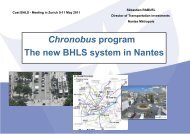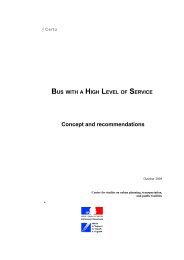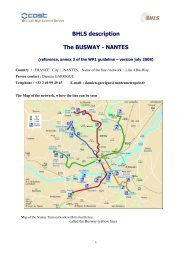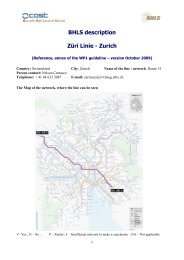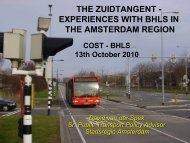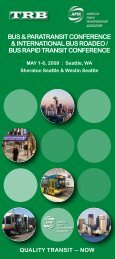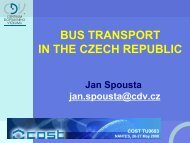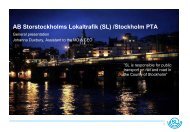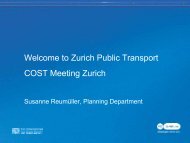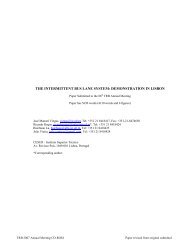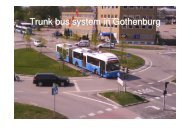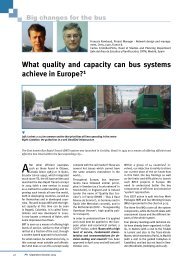Abstract_BHLS_Zurich..
Abstract_BHLS_Zurich..
Abstract_BHLS_Zurich..
Create successful ePaper yourself
Turn your PDF publications into a flip-book with our unique Google optimized e-Paper software.
Bus with High Level of Service<br />
Line 31<br />
<strong>Abstract</strong><br />
VBZ <strong>Zurich</strong><br />
November 2010<br />
Country: Switzerland<br />
Region / city : <strong>Zurich</strong><br />
Type of route : High-capacity, Urban<br />
Background / Context<br />
<strong>Zurich</strong> is the largest city of Switzerland, as well as the economic and financial engine of the country. With a<br />
population of about 380’000 inhabitants (metropolitan area around 1 million) <strong>Zurich</strong> is a mixed hub for railways,<br />
roads and air traffic. Its airport and railway station are the busiest in the country. Public transport services in the<br />
urban area are provided by a combination of high capacity commuter trains (S-Bahn services), a dense tram<br />
network and a number of complementary bus services varying in capacity. In general, quality of public transport<br />
in <strong>Zurich</strong> is very high, with clean, modern vehicles, and comfortable, reliable and punctual services. Line 31 is a<br />
major trolley bus line of the network, carrying more passengers than some of its tramlines. It is a radial line<br />
using double-articulated vehicles, which serves four S-Bahn stations, as well as the main train station. Diverse<br />
urban areas are served, including the city center, residential, and previously industrial areas (where the potential<br />
for further development exists). The use of large vehicles in Line 31 as of 2007 was the result of a study that<br />
focused on current and future demand, as well as on the quality of the service for the passengers. Line 31 is<br />
provided with different types of priority at all intersections and along the route, dynamic and static in-vehicle<br />
information, low-floor modern vehicles, central dedicated lanes along parts of the line, high frequency services<br />
and one park-and-ride facility. The use of a 25 m vehicle has reduced the difference between bus and tram in a<br />
city where the tram network is the backbone of the majority of trips.<br />
Description<br />
Infrastructure:<br />
Length:<br />
11 km<br />
Stations served: 28 (4 S-Bahn stations + <strong>Zurich</strong> main railway station)<br />
Average station spacing: 414 m<br />
Road Crossings: 23 at-grade intersections<br />
Buses :<br />
Type: 17 Double-articulated trolley buses – Hess Light tram 3<br />
Length/Width/Height: 24.7 / 2.55 / 3.45 m<br />
Capacity: Technical max. capacity: 202 (4 pass./m 2 )<br />
Rated output:<br />
2 x 160 kW (+ 50 kW emergency power)<br />
Doors / ramps: 5 / 2<br />
Empty / full weight: 24 / 38 Ton<br />
1
Bus with High Level of Service<br />
ITS tools :<br />
For passengers<br />
(visual and vocal<br />
information)<br />
For drivers<br />
For regulator<br />
Ticket vending machines, static schedules, topological and zonal maps in<br />
at station every stop. At larger stops real-time information displays. Audio<br />
announcements in case of disruptions or changes in service at every station.<br />
Real-time information displays: next/ final stop with travel time,<br />
disruptions or changes in service, special events, connection status at next<br />
on board<br />
stop with waiting time. Audio announcement: next stop, disruptions or<br />
changes in service.<br />
AVL, automatic priority request at all crossings, cameras at back of bus for safety<br />
AVL, CCTV in some vehicles, radio and emergency button contact with driver.<br />
Identification :<br />
On the bus<br />
On front and side of buses. Marketing is for entire system, it<br />
is creative, fun and the VBZ brand is strong and recognized.<br />
On the running ways Bus lanes are clearly marked; overhead catenaries help to follow the line path.<br />
At the stations<br />
Concrete surface and clear marking of the bus stop.<br />
Cost and Financing sources if available (in !)<br />
Cost coverage of service: around 64% for all system. Cost of one vehicle: around 1 Mio !. Single ride 3!, 24h<br />
ticket 6!. Discounts and season tickets are available and savings compared to single tickets are significant.<br />
Some results<br />
Ridership : demand in peak hour: 1300 pass. / direction. Around 14’000 per day.<br />
Headways: 7.5 min from 6 am to 8 pm<br />
Schedule span: 5:30 to 00:30 (19 h)<br />
Commercial speed : around 19 km/h<br />
Success factors / Strengths<br />
Public transport in <strong>Zurich</strong> enjoys ample support by the population and has a very positive image.<br />
Priority for public transport is a key element in the city. Planners have good relationships with traffic<br />
engineers and are able to work cooperatively on improvement projects. <strong>Zurich</strong> developed a unique<br />
approach that applies an active approach (priority is provided only when a public transport vehicle is<br />
present) to all the traffic signals in its network. The payment system (proof of payment or self<br />
service fare collection) considerably accelerates boarding and alighting times, thereby reducing<br />
dwelling times at stations. Vehicle characteristics such as low-floor, improved interior circulation<br />
spaces and multiple wide doors make the service faster, more comfortable and more accessible.<br />
Barriers / weaknesses / Points to monitor<br />
Public transport in <strong>Zurich</strong> is rather slow when compared with other cities. This is mainly due to the<br />
short distance between stations, and the density of the network. At some critical points, conflicts<br />
between public transport vehicles occur due to restricted space. <strong>Zurich</strong> is a tram city and bus services<br />
enjoy lower levels of recognition by the population. Construction sites can seriously impact services.<br />
Lessons learnt<br />
The high quality transport system in <strong>Zurich</strong> is not the result of one single measure, but rather the<br />
implementation of a number of measures that complement each other and have a greater effect than<br />
that which they could individually achieve. Public support is critical to implement measures in<br />
favour of public transport. Network planning, infrastructure allocation and service characteristics<br />
must be designed to meet conditions in public areas, serve all social groups including elderly, poor<br />
and disabled while minimizing unnecessary negative impacts.<br />
References and contacts for further details<br />
Person contact : Nelson Carrasco<br />
Telephone : +41 44 633 3087 - nelson.carrasco@ivt.baug.ethz.ch<br />
2



